EPA’s failure to regulate ultrafine particulate emissions producing cancer soup of urban air
The ambient air you and I are breathing is more dirty and more dangerous with every passing year. Transportation system emissions from combustion of gasoline and diesel increase in proportion to the number of vehicles on the road and the gallons of fuel being burned. The chart below records the gasoline sales per day in Kentucky coming in at more than 800,000 gallons.
In the 5 county KIPDA area including Jefferson County I roughly estimated (based on 2030 anticipated 33 million reported miles traveled per day) we’ll use 2.2 million gallons of gasoline combusted each day. Multiplied times $ 3.60/ gallon = $ 7.92 million dollars per day on fuel = $ 55.44 million per week on the high end. We spend four times as much on fuel as on Metro government services per week. (Total Metro Government services costs $ 12.8 million per week; thats $ 1.82 million per day (total 2013-2014 budget of $ 666,463,200). Based on those calculations residents and businesses spend at least = $ 2.9 billion per year in the KIPDA area on transportation fuels.
Obviously a powerful market that will be defended by its operators at all costs and will wield political influence at every turn in our American system of democracy. That political influence has captured the EPA which is sitting on its hands and refusing to go forward with necessary UFP emissions standards because the transportation engineers and gasoline dealers can’t take the hit, and are refusing to convert to the next generation of hydrogen or electric vehicles that don’t spew cancer soup but which would drastically reduce fuel sales.
A low emissions light rail system that reduced 10% of the fuel market would subtract $ 290 million per year from the
KIPDA dealers pockets and would be opposed in political forums if it ever came close to a vote. Opposition to light rail is more about protecting $ 290 million dollars in fuel sales or a 10% share of the market than on any rational argument against lowering emissions and providing transit options.
A recent study by the transportation sector funded - HEI Review Panel on Ultrafine Particles, titled Understanding the Health Effects of Ambient Ultrafine Particles, reviewed 42 articles published since 1997 and issued a, ‘more research needed’ assessment of UFP health impacts.
“The unique physical properties of UFPs, their interactions with tissues and cells, their potential for translocation beyond the lung—have led scientists to expect that UFPs may have specific or enhanced toxicity relative to other particle size fractions and may contribute to effects beyond the respiratory system. However, the considerable body of research that has been conducted has not provided a definitive answer to this question.”

PM 10 big particulate
5 large PM 10 particulates in a cubic centimeter of air that is otherwise clean. EPA regulates and limits ambient air concentrations of large PM 10 emissions particulates. Newer diesel engines remove large emissions particulates using high pressure fuel injection technology and ignition timing computer controls. Exhaust filters capture larger particulates. The technology is hyped as ‘clean diesel.’
Ultrafine particulate cancer soup
The combustion emissions carbon and organic carbon particulates don’t disappear, they are ‘downsized’ into ultrafine particulates which are not detected by current EPA mandated testing procedures. Ignition timing and ultra-high pressure fuel injection engine designs are producing ultrafine or ‘nucleation mode’ particulates. The result is a cancer soup of below detection limit UFP.
Ultrafine diesel emissions particulate
“Exhaust pipes of modern diesel engines present particle size distributions centered at∼80 nm with a typical number concentration close to 2.0107 per cm3 Total carbon (TC) of diesel PM consists of elemental and organic carbon (EC and OC). EC is formed during fuel pyrolysis, and it is principally graphitic carbon. OC is originated from incomplete fuel combustion and slip of lubrication oil past engine seals; and it primarily consists of polycyclic aromatic hydrocarbons (PAHs) and aliphatic hydrocarbons.
PAHs are harmful substances for human health due to their high carcinogenic, mutagenic, and allergenic potential;2 more than 100 different PAHs have been found in PM. Indeed, soot particles can transport genotoxic compounds across the cellular membrane acting as a Trojan horse. “
Lizaragga et al, Effect of Diesel Oxidation Catalysts on the Diesel Particulate Filter Regeneration Process, Environ. Sci. Technol. 2011, 45, 10591–10597
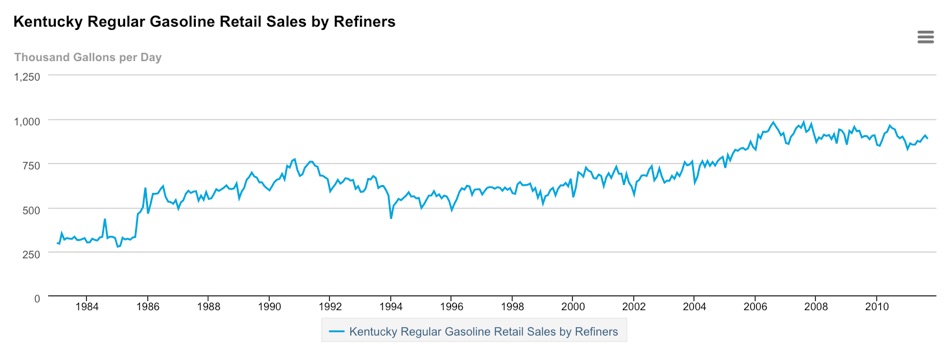
My seat of the pants estimates (please correct me)
1 million KIPDA area vehicles with a replacement rate of 10% per year = 100,000 new vehicle sales per year. Estimate 100,000 vehicles cost average of $ 18,000 each = $ 1.8 billion of vehicles sold per year in KIPDA town. Light rail alternatives that reduce vehicle sales are not politically favored.
Low emissions light rail that reduces 10% of the vehicle market would be opposed in political forums if it ever came to a vote. The entrenched transportation market elites are making huge profits off the present cancer soup systems and are fielding and electing political candidates at the local and state level that are 'correct' on these issues (conservative, anti-environmental) The fuel and vehicle market makers have plenty of funds to PURCHASE democracy. Those politicians appoint and control the regulatory agencies who have slowed the advance of regulation based on present scientific understanding of emissions impact to a crawl. EPA has spent millions on UFP research since the 1990s, but no regulations have been promulgated to set NAAQS standards.
2.2 million gallons of fuel combusted each day in 5 county KIPDA area times $ 2.88/ gallon price from refiners to resalers = $ 6,336,000 per day cost to dealers. $ 7.92 - $ 6.33 = about $ 1.6 million per day profit on fuel sales in KIPDA area or $ 580 million profit per year for the people selling us gas at retail. Just 1% of those profits pooled is $ 5.8 million to spend on public relations and political contributions in the KIPDA area.
Cars cost KIPDA area residents about $ 6 billion per year to fuel, drive, replace and insure but not including repairs, parking costs, speeding tickets.
The transportation system costs too much, to an increasing number of lower middle class and impoverished familes, wastes too much fuel on discretionary trips for low priority errands, and the cancer soup emissions exceed the capacity of the airshed to store the pollution without climate change effects.
We are in the throes of opening our eyes to the reality that the combustion fuel transportation system has to transform to a low or no emissions mobility plan. Market titans are not ready to abandon the cancer soup system that is filling their pockets.
IPCC Climate Change Chart
Bridges Consultant traffic demand numbers
The TOD Time of Day model output was used to provide a system‐wide comparison of the alternatives"
CDM Smith forecasted for the 5 county KIPDA area a daily vehicle miles traveled in 2030 of 33 million vehicle miles traveled each day. That would be more than a million vehicles driving somewhat less than 30 miles every day.
33 million miles divided by 15 miles per gallon gives 2.2 million gallons of gasoline combusted each day. That means every day in KIPDA town in 2030 we fill up 3.5 Olympic-sized swimming pools with fuel and set fire to them.
We do this in order to commute to work at the Big Box Warehouse for less than a living wage, or go to Grease Burger to buy a double cheese burger with bacon--important trips. When people have a car in the driveway, they use it rather than walking two blocks.
Millions of such trips per day causing release of huge amounts of combustion emissions in the KIPDA area day after day. Not counting the emissions from jet aircraft engines at the Worldport that can equal 500 vehicles for each take off and landing cycle.
This mind boggling excess and poisonous waste that is killing us and our environment is strenuously defended as ‘good business’ and vast public funds are appropriated to support and rebuild its infrastructure year after year. We are merely one such community following the same pattern out of millions globally. Henry Ford was such a stupid 'get,' to paraphrase the Beatles.
630,000 gallons of water fit in an Olympic-size swimming pool.
See, the Steer Davies and Gleave Traffic Group
Louisville-Southern Indiana Ohio River Bridges Traffic & Revenue Study Final Report August 30, 2013
Total Louisville Bridge crossings 2010 were 226,700 per day Total crossings 2012 were 224,300 per day--a drop of 2,400 cars per day all crossings from 2010 to 2012-- a 1.05 % decline in 2 years.
Climate Panel Says Upper Limit on Emissions Is Nearing
Justin Gillis, New York Times
September 27, 2013
“Going well beyond its four previous analyses of the emissions problem, the Intergovernmental Panel on Climate Change endorsed a “carbon budget” for humanity — an upper limit on the amount of the primary greenhouse gas, carbon dioxide, that can be emitted from industrial activities and forest destruction.
To stand the best chance of keeping the planetary warming below an internationally agreed target of 3.6 degrees Fahrenheit above preindustrial levels and thus avoiding the most dangerous effects of climate change, the panel found, only about 1 trillion tons of carbon can be burned and the resulting gas spewed into the atmosphere.
Just over half that amount has already been emitted since the beginning of the Industrial Revolution, and at current rates of energy consumption, the trillionth ton will be released around 2040, according to calculations by Myles R. Allen, a scientist at the University of Oxford and one of the authors of the new report. More than 3 trillion tons of carbon are still left in the ground as fossil fuels.
Limiting the warming to the agreed-upon target “is technically doable, but at the moment we’re not going in the right direction,” Dr. Allen said in an interview. “I don’t think we’ll do it unless we bite the bullet and start talking about what we’re going to do with that extra carbon that we can’t afford to dump into the atmosphere.”
To keep using fossil fuels beyond the trillionth ton of emissions, companies would have to develop potentially expensive technology to capture carbon dioxide from emissions sources like power plants and store it underground. Such efforts have been lagging badly; only last week, Norway scaled back one of the most ambitious such projects because of soaring costs.”
http://www.nytimes.com/2013/09/28/science/global-climate-change-report.html?hp&_r=0
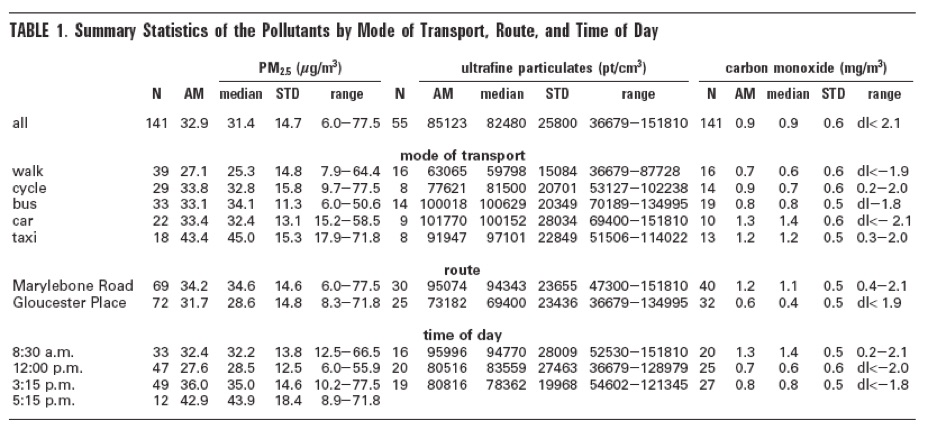
Exposure to urban cancer soup UFP - you are what you breathe
A study from 2009 in London collected samples of urban air as people walked and biked along busy traffic routes. The peer reviewed journal article reported that traffic emissions were the source of high levels of ultrafine particulate exposure. The chart above shows that a typical cubic centimeter of air a pedestrian breathes can contain a range of from 36 thousand to 87 thousand ultrafine particulates along sidewalk routes. The highest samples collected were from bus passenger exposure that ranged between 70 thousand to 140 thousand UFP per cubic centimeter of air. Walking showed the lowest exposure in the study. Vehicle passengers and drivers are in the direct path of UFP emissions traveling in roadways. The ultrafine particulate soup coats the lung tissue with cancer causing chemicals on particles so small they cross the cell membranes and enter the blood stream.
“For the ultrafine particle counts, the mode of transport was the fixed factor variable, and wind speed, temperature, and traffic flow were the covariates. There was a significant difference in ultrafine particle count levels experienced on the different modes of transport after controlling for the covariates. Mode of transport was the strongest determinant,
followed by traffic count, temperature,and wind speed, which explained respectively approximately 13, 12, and 6% of the variability in ultrafine levels.
The study found personal exposure could be lowered by traveling on roads with less traffic.
Kauer et al, Determinants of Personal Exposure to PM2.5, Ultrafine Particle Counts, and CO in a Transport Microenvironment,
VOL. 43, NO. 13, 2009 / ENVIRONMENTAL SCIENCE & TECHNOLOGY
Cancer Soup from vehicles
Mutagens from combustion emissions are widely distributed regionally according to a peer reviewed study-- Pedersen et al, Human Cell Mutagens in Respirable
Airborne Particles from the Northeastern United States. Quantification of Mutagens and Other Organic Compounds. Environ. Sci. Technol. 2005, 39, 9547-9560
“Human exposure to respirable airborne particles (<2.5 ím in aerodynamic diameter; PM2.5) is associated with increased risks of cardiopulmonary and lung cancer mortality.” [T]he finding that unsubstituted-PAHs and oxy-PAHs are important mutagens in the RO, KS, and QB samples suggests that combustion emissions, many of which contain high levels of PAHs(54-56), are significant sources of mutagens in PM2.5, and that their distribution is similar across the entire region.”
National transportation policy setting the course for climate catastrophe
A cabal of state governors, state transportation officials, investment banking interests, transportation engineers, suppliers, manufacturers and labor interests amounting to an all but unstoppable bi-partisan lobbying force is set to draft the next funding legislation for highway infrastructure.
Continuing a series of meetings to set objectives, on November 21, these groups will meet in The Liaison Capitol Hill Hotel Metropolitan Ballroom in Washington DC in a program titled:
National Transportation Infrastructure Summit to Address Threats to U.S. Economy Including Congestion, Unreliability and Funding
As spelled out in a September 25 meeting of the Senate Committee of the Environment & Public Works, chaired by California Senator Barbara Boxer, the objective is to find “sustainable funding” for the Highway Trust Fund, the federal piggy bank that provides billions of dollars in financing for state and bi-state transportation related projects across the country. The Highway Trust Fund has been operating in the red, spending $ 14 billion more annually than it accumulates in revenues from gasoline taxes. The Trust Fund has had bailouts from the General Fund to the tune of some $ 55 billion dollars and needs another $ 100 billion for the next five years.
The cry to raise national revenues to put the Trust Fund in the black is supported by the fear that decaying national infrastructure is putting the driving public at risk. One in four of the nations bridges is functionally obsolete, Boxer said. What is not being voiced in the bi-partisan pow-wow is the collision course of national transportation policy with limits to carbon emissions globally.
The self interested marketplace forces, the transportation -industrial complex (TIC) knows that it has the political power to get legislators to approve massive funding for the Trust Fund that provides huge revenues into state highway projects. This is a massive jobs project that has two troubling aspects. First, transparency. Major projects that go through the federal funding NEPA process are getting fast track changes to the NEPA law that will be coming forward in the funding bill. Measures that weaken NEPA obscure both the disclosure of actual environmental impacts and the true cost of projects. Public-private partnerships using federal fund guarantees bloat into longterm toll financed mega projects that commit rich and poor alike to daily fees to use the transportation system. The once ‘freeway’ will become a ‘tollway’ with annually increasing toll fees. In Louisville, Kentucky, the tolled two bridges project will feature annual increases in toll fees for at least the next 46 years and a bloated Tolling Authority of bureaucrats that costs as much as a new bridge itself.
Democrat Barbara Boxer
The massive funding in the Trust Fund bill will be diverted --much of it--into the pockets of bankers and financiers, who convert paid-for projects into longterm revenue funds for bureaucratic fee collection authorities that produce nothing except bills and penalty fee collection. The major infrastructure being built is a rentier class that rents out our national transportation infrastructure to us. No one is calling for full transparency and comparison of costs in the Barbara Boxer Trust Fund project.
Second, Global Climate Change.
The TIC members are overwhelmingly about protecting the market share of automobile manufacturers and dealers and their national gasoline appetite that consumes (and burns) some 360 mIllion gallons of gasoline per day. The federal Energy Information Agency says: In 2011, the United States consumed about 134 billion gallons of gasoline, a daily average of about 367.08 million gallons. Burning a gallon of gasoline with 10% ethanol produces about 17.68 pounds of CO2.
The 2013 Warsaw Climate Change Conference now underway in Poland is citing the urgent need for countries to enact policies that consider and adapt to the potential for global climate catastrophe caused by human transportation and power emissions. No Highway Trust funding legislation should go forward without an integrated climate change adaptation scheme that cuts out annual combustion of 134 billion gallons of gasoline substantially over the life of the funding measure. It is national suicide to pledge billions of bloated federally backed financing to the national highway system that is spinning up killer tornados, catastrophic storm surges and ultimate climate change catastrophe for the near term profits of the auto industry and fuel markets.
The crisis makes the U.S. Highway Trust fund legislation a pivotal, potentially fatal, policy decision. Right now all that is on the table is “sustainable funding” not a “sustainable planet.”
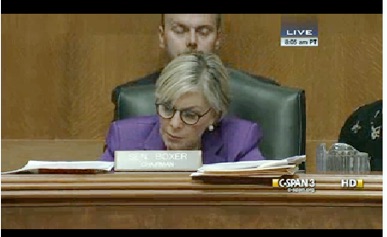

Summit Speakers
-
•U.S. Senate Environment & Public Works Committee Chairman Barbara Boxer
(D-Cal.)
-
•U.S. House Transportation & Infrastructure Committee Chairman Bill Shuster
(R-Pa.)
-
•U.S. Department of Transportation Deputy Secretary John Porcari
-
•Former U.S. Department of Transportation Secretary Norman Y. Mineta
-
•Gov. Bill Graves, President & CEO, American Trucking Associations
-
•U.S. Rep. John Delaney (D-Md.)
-
•Sean Connaughton, Secretary, Virginia Department of Transportation
-
•Olof Persson, President & CEO, Volvo Group
-
•David Abney, Chief Operating Officer, UPS
-
•Greg Cohen, President & CEO, American Highway Users Alliance
-
•Jay Timmons, President & CEO, National Association of Manufacturers
-
•Joe Cowan, CEO, Cowan Systems
-
•Matthew Shay, President & CEO, National Retail Federation
-
•Don Kopec, President, Association of Metropolitan Planning Organizations/Deputy Executive Director for Programming and Operations, Chicago Metropolitan Agency for Planning
-
•David Parkhurst, General Counsel and Staff Director, National Governors Association
-
•Bud Wright, Executive Director, American Association of State Highway & Transportation Officials




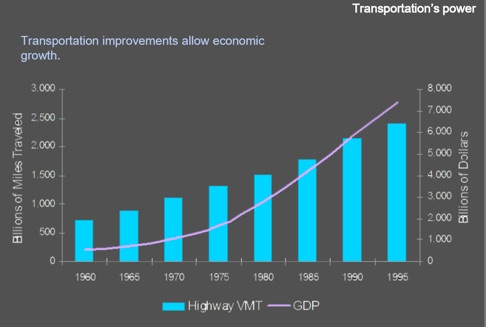
One logo missing in the Move Louisville consultation
See and Download a slide presentation for MoveLouisville at
http://www.louisvilleky.gov/economicdevelopment/MoveLouisville/
The slides show Metro Government is going to say nice things about light rail transit and is going to talk about a goal of 20% reduction of greenhouse gas emissions from transportation and a 20% reduction in vehicle miles traveled as a goal.
The slides also seem to promote new federal tax and other funding mechanisms for the Highway Trust Fund--they are going to cry about crumbling infrastructure and the spending gap between the Trust Fund revenues and the actual spending.
Metro Government MoveLouisville slides show the Trust Fund shortfall so, seems like this is part of a coordinated effort to ask the public to support Trust Fund refunding legislation. But the slides:
1) Don't describe regional transportation planning’s relationship with one of the world's largest auto manufactures -FORD
FORD employs more than 8,500 in Louisville
manufactures more than 1,000,000 ROAD vehicles per year
Is it even possible to get a transit project in Louisville without FORD's permission?
Why isn’t FORD a presence at a regional transportation planning consultation since their plans for the future of urban transportation are a lot more likely to occur than Metro Governments?
-
2) Move Louisville explain why since 2008 we have had a Metro goal to reduce GHG emissions from the transportation sector but when the
$ 2.4 billion (plus $ 8 billion toll fees) Bridges Project was put through--there was no GHG analysis of how choosing a Downtown transit option
as part of the federally funded project could have met the 20 % reduction goals. Now ---after the horse has left the barn--everybody want to talk about greenhouse gas.
3) Transportation Energy: This is the energy section from the Louisville Bridges Project 2001 DEIS
5.13 ENERGY
Transportation accounts for a major portion of both direct and indirect energy consumption in the U.S. Direct energy consumption is that which is consumed by vehicles traveling on the roadways, while indirect energy consumption refers to the energy consumed during the
construction and maintenance of a new facility. Energy consumption for vehicle operation and facility maintenance represents longer-term energy impacts while construction energy is typically
a large one-time energy expenditure.
The energy impacts of the project alternatives reflect both direct and indirect energy consumption. Estimates of unit quantities of construction materials and activities have been translated into an equivalent energy requirement. The factors used in calculating the indirect construction energy consumption are 17.1 x 109 BTU's per lane-mile for roadways 130.4 x 109 BTU's per lane-mile for bridges, and 195.6 x 109 BTU's per lane-mile for tunnels.
5.13.2 Operational Energy Consumption
Operational energy consumption is based on vehicle miles traveled (VMT), the average operating speeds, and the fuel consumption rates by type of vehicle adjusted by a fuel economy factor for the design year. Alternatives that reduce VMT, increase speeds, or reduce the time vehicles are on the road will reduce the operating energy consumption as compared to the No-Action Alternative.
The No-Action Alternative is estimated to have an annual operating energy consumption of 37.5 trillion BTUs. The Transportation Management Alternative would show no change. The One Bridge/Highway Alternatives are estimated to increase operating speeds and, except for the Near East Alternative, increase VMT. This results in estimated annual operating energy consumption equivalent to the No-Action Alternative. The Two Bridges/Highway Alternative would exhibit
the greatest saving in annual operating energy consumption compared with the No-Action Alternative due to reduced VMT and increased speeds. The Far East and C-1/C-3 Alternative and Near East and C-1/C-3 Alternative are estimated to have an operating energy of 37.3 trillion
BTUs, a savings of 200 billion BTUs annually. The Far East and C-2 Alternative and Near East and C-2 Alternative are estimated to have the greatest savings of 300 billion BTUs annually, with an estimated consumption of 37.2 trillion.

37.2 trillion BTUs
That appears to equate to using 297.9 million gallons of gasoline annually as 'operational energy' consumption for the Louisville Bridges Project highway area.
297.9 million gallons of gas at $ 3.50 per gallon costs
$ 1,042,650,000 annually or $ 1,000/year for a million drivers.
a 20% reduction in energy would be 59.5 million gallons of gasoline not burned. at $ 3.50/gallon thats a loss of local gasoline sales of $ 208,530,000. Do you think they will eagerly embrace that?
Transportation choices have real world economic and pollution trade offs, but there is no real world market analysis in MoveLouisville and its transit plans and VMT reduction goals are not explained in the context of a real political system that runs on money.
<http://www.skepticalscience.com/why-450-ppm-is-not-safe.html>
Why 450 ppm is not a safe target
On January 13, 2014 in the TARC headquarters at Union Station on Broadway, the City of Louisville hosted a public consultation process to introduce the agenda and some waypoints on the path to producing a transportation project plan for Louisville. As explained by the Mayor’s representative, Patti Claire, the public map marking process would produce some priority projects to be submitted to KIPDA for inclusion in the TIP-Transportation Improvement Program list of state and federal funded projects.
At the front of the slide presentation, the consultant introduced some fuzzy concepts underlying project selection such as ‘connectivity’ and sustainability. There was no discussion of automobile numbers in the community or projection of numbers of vehicles by decade. The future of transportation in the community has a lot to do with whether car dealers continue to sell tens of thousands of vehicles per year to add to the local fleet. One slide did predict that the urban core would lose 20,000 residents and the outside Gene Snyder highway area would gain 170,000 by 2050. That urban sprawl style of development could only be based on automobile fleet expansion.
The City did not include concepts of social justice as a basis for planning or maps showing the striking pattern of race and class segregation in Louisville. In response to a question the consultant said they had been hearing a lot of input that one part of the city was unemployed and needed transportation to another part where the jobs were.
The approach in the slide presentation was lacking in a lot of the gritty details of Louisville’s actual transportation context. Bits of insight came out through several audience questions. For instance upon questioning as to why FORD Motor Company was not participating in the Move Louisville consultation, Claire said they were in discussions with FORD in another segment of the TIP preparation devoted to freightways.
The major corporate shipping and manufacturing businesses are meeting separately to get the future of transportation in Louisville they want. The public is walled out of that discussion.
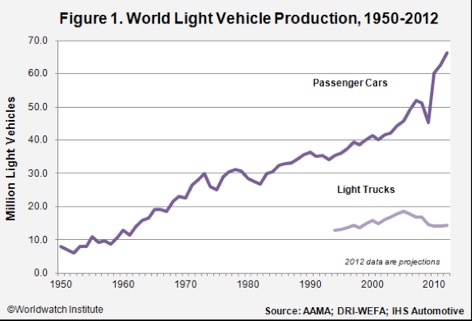
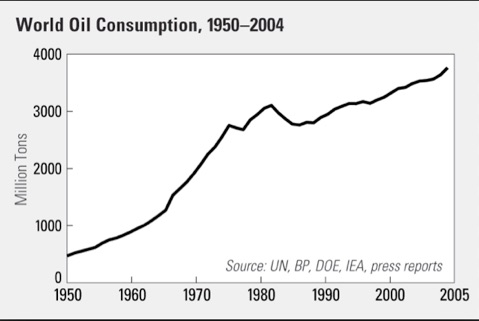
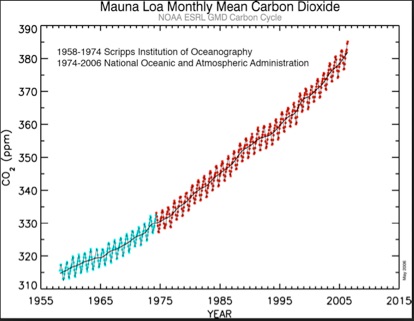
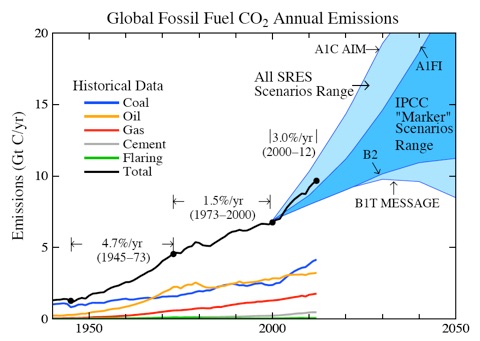
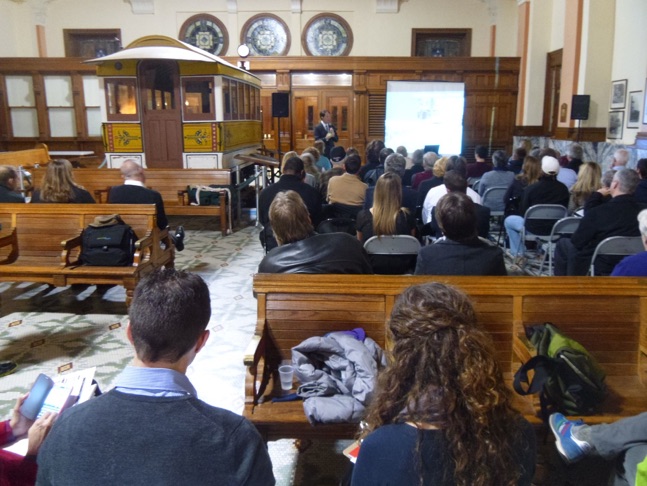
In that other discussion, the trucking operations may be getting the things they are seeking such as multi-million dollar public funded road projects that serve freight connectivity purposes and suck up federal funds that would be available for public transit projects.
Public transit in the form of a light rail project was high on the list of a number of attendees. The excavation of buried streetcar rails and reconstruction of a streetcar line was mentioned by several speakers. The consultant seemed to place all these ideas in the same pot on an equal basis without relating them to the social justice aspects or greenhouse gas emissions of various modes. A great service would be done by describing the operating life emissions of a streetcar line versus a busy street full of cars in a particular corridor.
The city has been admitting that this listening project has produced numerous calls for establishment of a light rail or streetcar line. But such ideas have been smothered in the cradle before. Louisville is the home of one of FORD Motor Companies major car and truck manufacturing centers. Its doubtful that local political leaders will advance a light rail mode that conflicts with FORD’s Future of Mobility concepts. Those include science fiction concepts of connected ‘smart cars’ that organize themselves into tight packed ‘trains’ moving as one down concrete tollways.
A consultation with reality is overdue. Continued expansion of automobile culture will give us a post apocalyptic future of food riots, war and famine for the many and fortress enclaves for the few.
See climate science here: <http://www.columbia.edu/~mhs119/>
See the run up to the Congressional action to refund the Highway Trust Fund at these highway lobby webpages:
<http://www.transportation.org/Pages/default.aspx>
AASHTO is a nonprofit, nonpartisan association representing highway and transportation departments in the 50 states, the District of Columbia, and Puerto Rico.
American Highway Users
260 days before Congress must take action on a Highway bill.
CSPAN Video : <http://www.c-spanvideo.org/program/TransportationInfr>
See FORD Climate Change webpage
<http://corporate.ford.com/our-company/governance-hub/contact-board-829p?releaseId=1244754318579>
Board of Directors
Ford Motor Company
P.O. Box 685
Dearborn, MI 48126-0685
U.S.A.
Climate Change
Ford is committed to doing our share to prevent or reduce the potential for environmental, economic and social harm due to climate change.
Our climate change strategy is based on doing our share to stabilize carbon dioxide (CO ) concentrations in the atmosphere at 450 parts per million (ppm), the level that many scientists, businesses and governmental agencies believe may avoid the most serious effects of climate change.
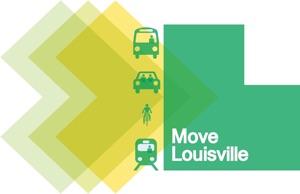
Welcome to BadwaterJournal.com©
TARC Headquarters Union Station
“Evidence has been accumulating during the past decade providing strong suggestions that exposure to high levels of high pollution, very common in many cities all around the world, is associated with damage to the CNS.
Human and animal studies have evidenced a series of common adverse effects of air pollution (PM in particular), with oxidative stress and neuroinflammation emerging as the hallmark effects. A variety of behavioral alterations has also been reported, together with changes in some neurotransmitter systems. These and other aspects of air pollution neurotoxicity need to be further investigated.
Newman et al. [51] reported hyperactivity in 7-year-old
children associated with early life exposure to traffic related
air pollution. Two studies by Volk et al. [52, 53] found that
residential proximity to freeways and gestational and early life exposure to traffic-related air pollution were associated with autism (OR = 1.86; 95% CI 1.04–3.45). This was confirmed by another recent study in which perinatal DE exposure was significantly associated with autism spectrum disorders (ASD), particularly in boys [54]. The latter findings are particularly of interest, as there is increasing evidence indicating that children with ASD have higher levels of oxidative stress [55–57], as well as increased neuroinflammation and systemic inflammation [58–60]. As noted earlier, these are the typical effects found in individuals exposed to severe air pollution.
Particularly troublesome is the suggestion that air pollution
may contribute to the etiopathology of neurodevelopmental
and neurodegenerative diseases (e.g., autism or dementia) whose incidence is increasing in the global populations.
Needless to say that, in addition to further biomedical
research to augment our understanding of the effects and
mechanisms of air pollution on the CNS,measures should be taken to curtail emissions and exposures.”
Neurotoxicants Are in the Air: Convergence of Human, Animal, and In Vitro Studies on the Effects of Air Pollution on the Brain
BioMed Research International
Volume 2014, Article ID 736385, 8 pages
Dying of Cars
The air particulate emissions of cars and trucks is emerging as the cause of damage to the central nervous system


Slides from Ultrafine Particles on and near Roadways: Exposure Assessment and Mechanism Understanding, Yifang Zhu , Ph.D.
Associate Professor Environmental Health Sciences Department Fielding School of Public Health University of California Los Angeles Available for free download on the web

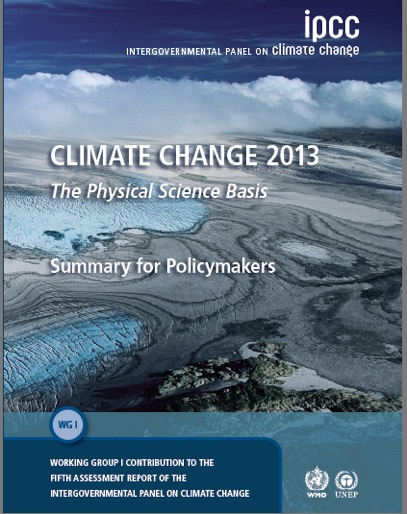
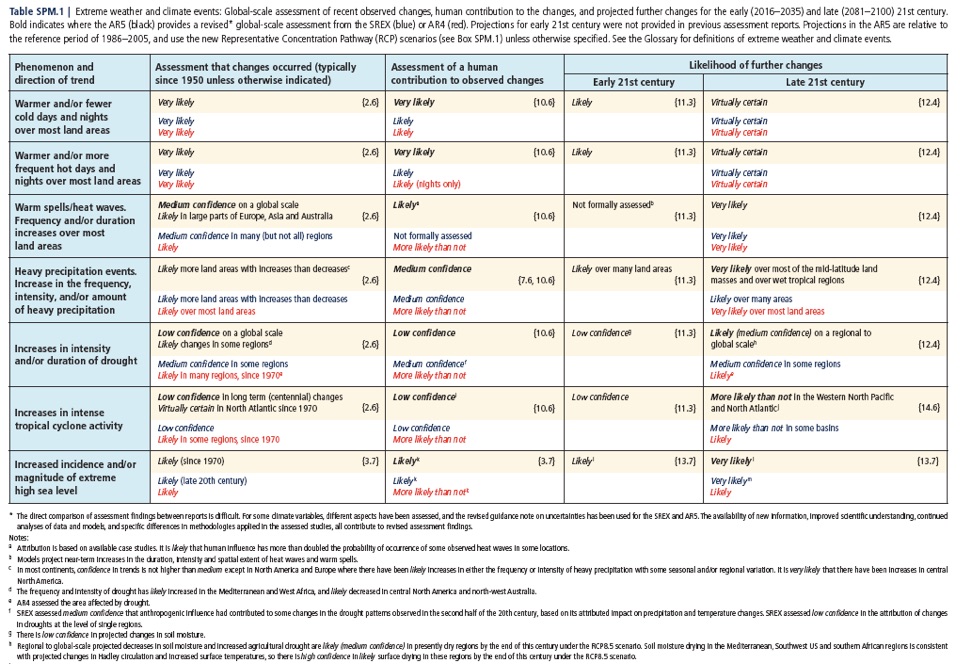
Bottom